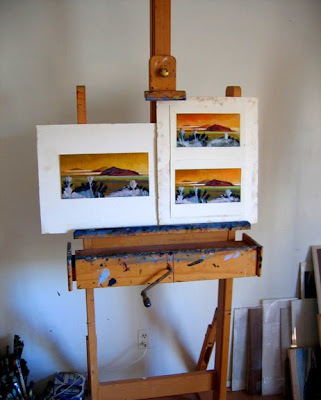Inner Sanctum
Philip Koch's crank-adjustable studio easel.
My studio. It's the place where I do my cooking. Like any cook, I have my favorite implements. I like to think we painters work with a little more vision and imagination than chefs (revealing my bias here, but heck, I'm a painter). The thing is about a painter's imagination- it can only be made visible by working through one's tools and materials. You can't impose your will on the painting. Instead you have to craft it into being. Here are a few tools that have made all the difference to me.
I spend enormous amounts of time, standing at this easel. I got into the habit of standing to paint in an interesting way. Years ago when I first started doing landscape paintings outside, I didn't have an easel. Instead I'd sit on the ground (tough in winter, trust me) and prop my canvas up against the back of my wooden paintbox that opened like a suitcase. It all worked reasonably well for a few years. Then I got a job teaching at the Maryland Institute College of Art. One day I was seated by the side of the road painting away in this fashion when the president of MICA drove by. It was Eugene Leake, himself a painter who did elegant broadly painted landscapes I admired very much. He was famous for his clipped responses. He simply slowed his car, rolled down the window, and yelled out "you'll have to get yourself an easel." Then off he went.
Well I went and bought one that week, my first portable French easel. No sooner had I taken it outside and started painting than I noticed something amazing- my paintings just got better. My exact words were "Huh!" Somewhat mystified, I looked at the question from all possible angles to understand what difference the easel made. And I came up with a number of sound ideas about exactly how it was helping me. Now years later, I've added another answer to that question. That is that our intelligence resides not just in our brains, but in ways we little understand, throughout the our body. If you stand up you move your limbs more and breathe more deeply. This stimulates your vision and your imagination. In short you paint better.
Nowadays in my drawing classes at MICA I make all my students stand up all the time. If anyone asks why I just tell them the Muse demands it.
A half dozen years ago I broke down and bought a high quality easel imported from Italy made by Mabef. Its chief selling point is it has a hand crank that raises and lowers the painting you're working on to exactly the height you want. This is a huge advantage. And it keeps me standing up and painting well.

With all that standing you might wonder if I get tired. Here's the view directly in back of my easel. Note the rocking chair pictured above. It is stationed strategically in front of a full length mirror that is aimed at whatever is in progress on the easel. Seeing the painting's image reversed, reduced in size, and a little bit darker all contribute to letting you see it with a fresh eye. Artists have used studio mirrors like this for centuries. I'm always confounded when I visit another artist's studio and they don't have a mirror handy. It is too good a tool to overlook.
I also highly recommend rocking chairs. There is something about that back and forth motion that seems to push one's frame of mind gently in a better direction. Artists have to envision how they can paint something better, and then how to improve it further still. A tall order. I find the rocking chair helps persuade that part of my imagination to simmer more productively. It's a way to rest but to also keep the body, and the mind, moving.
I've always notice that beginning painters get a lot of paint on themselves and all over their surroundings. Probably I did too. But I find that when a painting is going well, the paint tends to end up where it needs to go instead of on your shoes. Anything that helps corral the colors is a good thing.
Here's my brush holder, as you can see a veteran of decades of studio paint splatters and drips. I like to work with lots of brushes simultaneously, basically one for each of the major hues I'm employing for a given passage in the painting. Left to their own devices, loaded paint brushes have the unruly habit of rolling into each other and dirtying up each others colors. There's nothing as demoralizing as reaching for wide brush laden with a silver grey you've spent twenty minutes to mix up from just the right pigments only to have a big streak of offending pink stream out from the side of the brush that collided with its neighbor. So I sawed up pieces of 1/4 round pine stock from the lumber yard and affixed a row of them along a large board. The brushes stay at the ready, held in place by their slots. This device over the years has saved me countless hours of frustration as well as a mountain of precious oil pigments.
Of course, nothing matters for a painter as much as coming up with great ideas about what to paint. Artists need to grapple with images that speak at once to many sides of their personality. It is when you've gotten a firm grasp on developing a real vision for your paintings that you can sense how central well chosen tools are to your trade. Nothing happens without the magic of one's imagination. And nothing happens unless the magician is well practiced with just the right tools.




